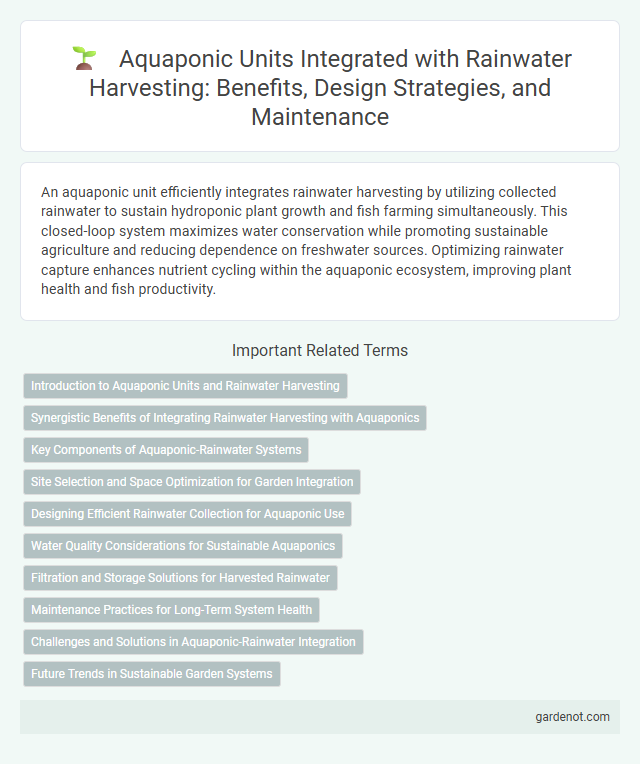An aquaponic unit efficiently integrates rainwater harvesting by utilizing collected rainwater to sustain hydroponic plant growth and fish farming simultaneously. This closed-loop system maximizes water conservation while promoting sustainable agriculture and reducing dependence on freshwater sources. Optimizing rainwater capture enhances nutrient cycling within the aquaponic ecosystem, improving plant health and fish productivity.
Introduction to Aquaponic Units and Rainwater Harvesting
Aquaponic units combine aquaculture and hydroponics to create a sustainable system where fish waste provides nutrients for plant growth, reducing water and resource use. Integrating rainwater harvesting into aquaponic systems enhances water efficiency by capturing and storing runoff, supplying clean water for both fish tanks and plant irrigation. This synergy optimizes resource management, minimizing reliance on external water sources and promoting sustainable urban agriculture.
Synergistic Benefits of Integrating Rainwater Harvesting with Aquaponics
Integrating rainwater harvesting with an aquaponic unit enhances water efficiency by capturing and recycling natural rainfall, reducing reliance on external water sources. This synergy improves nutrient recycling within the system, promoting healthier plant growth and fish health due to the consistent water quality and availability. Optimized water use and nutrient coupling in this integrated system significantly increase sustainability and productivity in urban agriculture setups.
Key Components of Aquaponic-Rainwater Systems
Key components of aquaponic-rainwater systems include a rainwater catchment area, filtration units, and storage tanks that ensure clean water supply for aquaponic operations. Integration of grow beds, fish tanks, and biofilters supports nutrient cycling and water purification in a closed-loop environment. Pumps and plumbing systems facilitate efficient water circulation between rainwater reservoirs and aquaponic units to maintain optimal water quality and system sustainability.
Site Selection and Space Optimization for Garden Integration
Selecting a site for an aquaponic unit within a rainwater harvesting system requires analyzing water availability, sunlight exposure, and proximity to the water source to maximize efficiency. Space optimization involves integrating vertical growing beds and compact fish tanks to enhance productivity while conserving garden area. Proper placement ensures sustainable water reuse, promoting healthy plant growth and stable fish habitats in limited urban or suburban gardens.
Designing Efficient Rainwater Collection for Aquaponic Use
Designing efficient rainwater collection for aquaponic units involves optimizing roof catchment areas and using first-flush diverters to ensure water purity. Incorporating filtration systems such as sediment filters enhances water quality, supporting healthy fish and plant growth in aquaponics. Storage tanks with controlled overflow and UV treatment prevent contamination, making rainwater a sustainable resource for aquaponic ecosystems.
Water Quality Considerations for Sustainable Aquaponics
Maintaining optimal water quality in aquaponic units is crucial for sustainable rainwater harvesting systems, as parameters such as pH, dissolved oxygen, and nutrient levels directly affect fish health and plant growth. Regular monitoring and filtration of harvested rainwater ensure removal of contaminants and balance essential minerals, promoting a stable aquatic environment. Implementing biofiltration and aeration techniques enhances water quality, supporting a resilient and productive aquaponic ecosystem.
Filtration and Storage Solutions for Harvested Rainwater
Effective filtration in aquaponic units involves multi-stage systems including sediment filters, biofilters, and UV sterilizers to ensure harvested rainwater is free from debris, pathogens, and contaminants. Storage solutions utilize food-grade tanks with controlled environments to maintain water quality and prevent algal growth, allowing consistent nutrient cycling for fish and plants. Integrating these filtration and storage methods enhances system sustainability and optimizes water reuse within rainwater-fed aquaponics.
Maintenance Practices for Long-Term System Health
Regular inspection and cleaning of filters, pumps, and grow beds in an aquaponic unit ensure efficient operation and prevent blockages that compromise water flow. Monitoring water quality parameters such as pH, ammonia, nitrite, and nitrate levels helps maintain a balanced aquatic environment essential for fish health and plant growth. Periodic replacement of worn components and managing nutrient levels support long-term system stability and productivity.
Challenges and Solutions in Aquaponic-Rainwater Integration
Integrating aquaponic units with rainwater harvesting systems presents challenges such as inconsistent water supply quality and nutrient balancing due to variable rainwater composition. Solutions include advanced filtration techniques, real-time water quality monitoring, and the use of buffer tanks to stabilize water parameters for optimal fish and plant health. Implementing IoT sensors and automated control systems further enhances the efficiency and sustainability of aquaponic-rainwater integration by ensuring precise nutrient and pH management.
Future Trends in Sustainable Garden Systems
Aquaponic units integrated with rainwater harvesting systems optimize water use efficiency by recycling nutrient-rich water for plant cultivation and fish farming. Emerging trends highlight the adoption of smart sensors and automated controls to enhance system sustainability and productivity in urban agriculture. Innovations in renewable energy integration and biofiltration techniques further advance the scalability of aquaponic units within sustainable garden systems.
Aquaponic unit Infographic

 gardenot.com
gardenot.com